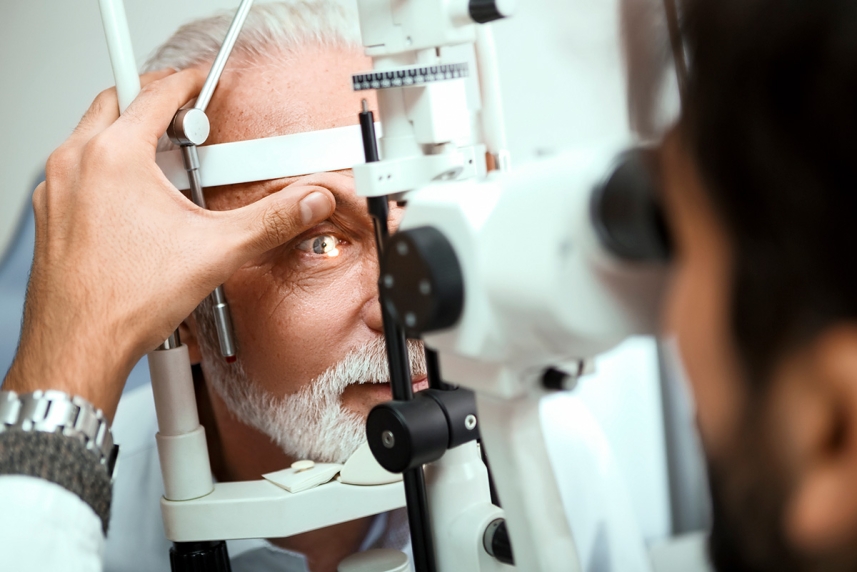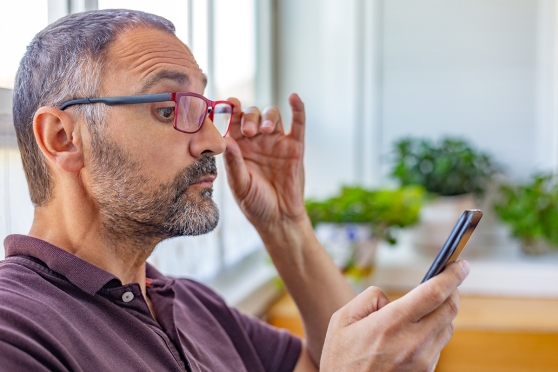Here’s what may happen after a diabetic retinopathy diagnosis
Getting diagnosed is the first step in protecting a person’s eyesight. Here’s how to work with an eye care provider to help keep this serious eye condition under control.

When a person finds out they’ve developed diabetic retinopathy, they might have a lot of questions, and that would make sense. It’s a serious eye disease, and it’s natural to wonder why it happened and what may come next. Luckily, an eye care provider may help with the answers — and guide patients on what to do next.
People with diabetes can develop this condition when their blood sugar levels are too high. Over time, high blood sugar levels can damage the body’s blood vessels. That includes the tiny ones in the retina, or the light-sensitive layer of tissue in the back of the eye.
When those small veins get damaged, they leak blood and other fluids. This causes the retinal tissue to swell. It may occur in one eye or both and left untreated, it may cause vision loss or even blindness. In fact, diabetic retinopathy is the most common reason for vision loss in people with diabetes.1
There are nearly 10 million people in the United States living with this serious eye condition, and 1 in 10 have the type that might threaten their vision. About 28% of people with diabetes and this condition are older adults between the ages of 65 and 79.2
The longer someone has diabetes, the higher their chances of developing diabetic retinopathy. That’s why yearly eye exams are so important. They may be one of the best ways to diagnose this type of eye condition.
Once an eye care provider diagnoses the eye disease, they’ll educate the patient and help come up with a treatment plan. Here are 4 things someone may expect after receiving a diabetic retinopathy diagnosis.
Stay on top of your eye health with an in-network provider. Search for an eye care provider now.
1. The eye care provider may go over the details of the disease.
An eye care provider may take a closer look at the retina through a dilated eye exam. That’s when they put drops in the eye to make the pupils get larger than normal. It helps them see if there are signs of diabetic retinopathy. If the eye care provider discovers the condition, they will discuss their findings with the patient.
“Once someone is diagnosed with diabetic retinopathy, the optometrist will inform them about the stage of the disease. They’ll also tell them whether the stage is mild, moderate or severe,” says Sherrol A. Reynolds, O.D., a professor of optometry at Nova Southeastern University’s College of Optometry in Fort Lauderdale, Florida. (She is also the chief of the Davie Primary Care Clinic and director of the Retina Clinic at the Eye Care Institute at NSU Health.)
Dr. Reynolds explains that there are 2 common stages of the condition:
- An early stage, known as nonproliferative. That means that new blood vessels aren’t growing (or proliferating).
- A more advanced stage, known as proliferative. That’s when new blood vessels are growing.
Eye care providers can determine the stage based on what they observe. This may include:3
- How much swelling and leaking there may be
- How many new blood vessels may be growing
- Whether there may be vision changes, such as blurry vision or floating spots
- Whether the veins in the eye may be getting blocked (which prevents the retina from receiving enough blood and oxygen)
Depending on the stage, the eye care provider may go over a treatment plan. In mild to moderate cases, this may only mean having to make lifestyle changes. It could include:
- Cutting back on simple carbohydrates, such as white bread
- Eating more fruits and vegetables
- Getting more physical activity
“Controlling blood pressure and cholesterol levels, as well as weight loss if the patient is overweight, are also things an optometrist may suggest, since these can make retinopathy worse,” says Dr. Reynolds.
2. The eye care provider may focus on managing diabetes.
Eye care providers play a key role in a person’s diabetes care team. They may provide patients with valuable education. That might include how controlling blood sugar levels can keep diabetes-related eye conditions from developing or getting worse.
At each eye exam, eye care providers may ask questions like:
- Is the person’s diabetes being monitored regularly?
- Is the person eating healthily?
- Is the person exercising regularly?
- Is the person taking their medication?
An important role of an eye care provider is to communicate with the patient and bring up diabetes management regularly, notes Dr. Reynolds.
Reducing A1C levels, which measure the average blood sugar levels over the past 3 months, can also reduce the chances of diabetic retinopathy, Dr. Reynolds adds. That’s because higher levels are linked to diabetes complications, including those involving the eyes.4
“Evidence has shown that if you go down 1% in your A1C levels, you may reduce the risk of diabetic retinopathy by 21%, and going down 2% may decrease the risk by 63%,” explains Dr. Reynolds.
3. The eye care provider may touch base with the rest of a patient’s care team.
When it comes to eye conditions, eye care providers may be at the center of a patient’s diabetes care, but it’s also important for them to communicate with a patient’s other health care providers “to let them know about the patient’s eye health,” says Dr. Reynolds. “If diabetic retinopathy is diagnosed, we’re going to send a record or report of the diabetes exam to the patient’s treating physician.”
Along with talking with the person’s primary care doctor, the eye care provider may also reach out to other health care providers, such as their endocrinologist, to keep them up to date on their eye condition. (That’s a doctor who specializes in hormone-related conditions.)
When everyone is on board and checking in with one another, it’s a win-win in terms of keeping diabetes in check and preventing serious eye conditions from getting worse.
4. An eye care provider may set a patient’s eye exam schedule.
The stage of the disease may determine how often the patient may need to see their eye care provider. “If they have mild or moderate nonproliferative retinopathy, the patient will be scheduled for a follow-up exam with the optometrist every 3 to 6 months to monitor the progression of disease,” says Dr. Reynolds.
If someone has a more severe case, they may be referred to a retinal specialist for further treatment. This could include eye injections, laser treatments or even surgery. “The optometrist will let the patient know if they need to see a retinal specialist as soon as possible or within 1 to 2 weeks,” says Dr. Reynolds.
Making and sticking to regular eye care provider appointments is an important part of monitoring diabetic retinopathy and other serious eye conditions. Routine visits may also help people manage diabetes and help ward off vision loss, so they may keep their eyesight as sharp as possible for long as possible.
Providers in the UnitedHealthcare Vision Network are here to help keep your vision healthy. Search for a provider now.
Sources:
- Diabetic retinopathy National Eye Institute, last updated November 2023.
- Prevalence of diabetic retinopathy Centers for Disease Control and Prevention, last reviewed June 2023.
- Eye health: diabetic retinopathy American Diabetes Association, June 2023.
- All about your A1C Centers for Disease Control and Prevention, last reviewed September 2022.


